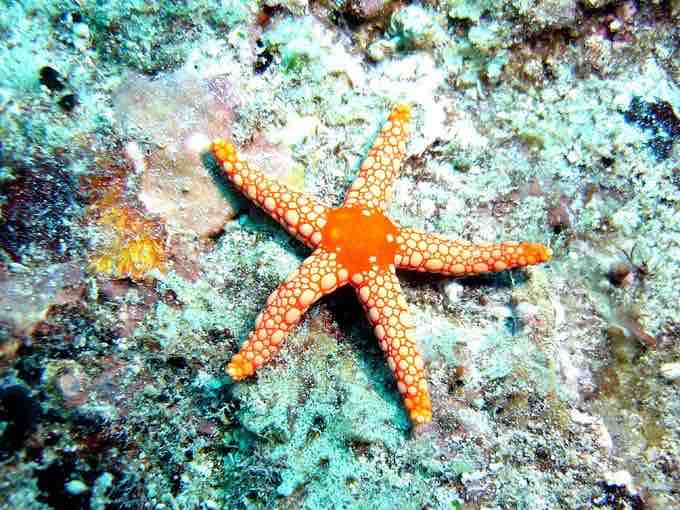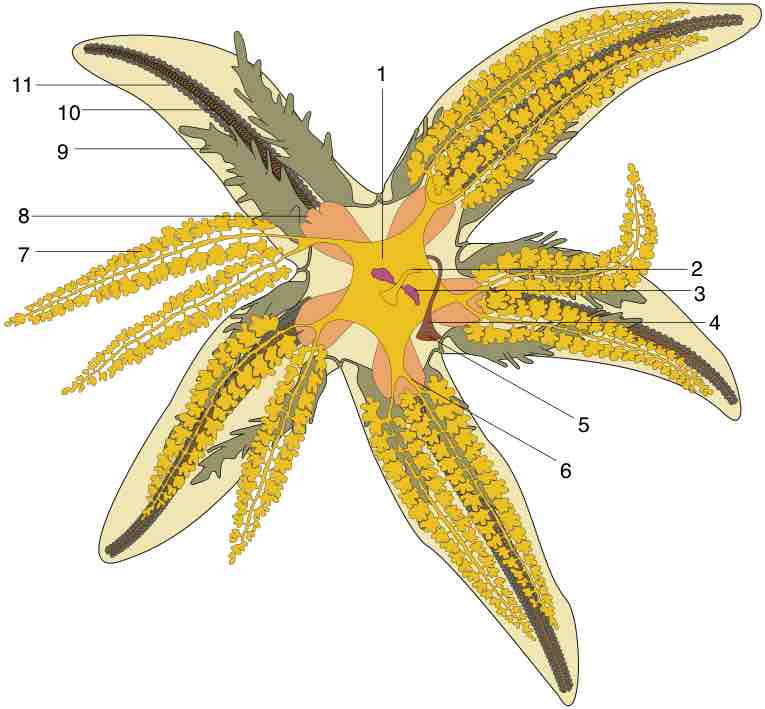Phylum Echinodermata
Echinodermata are so named owing to their spiny skin (from the Greek "echinos" meaning "spiny" and "dermos" meaning "skin"). This phylum is a collection of about 7,000 described living species. Echinodermata are exclusively marine organisms. Sea stars, sea cucumbers, sea urchins, sand dollars, and brittle stars are all examples of echinoderms . To date, no freshwater or terrestrial echinoderms are known.

Sea stars
Star stars are among the most familiar of marine invertebrates. They are members of the phylum Echinodermata.
Morphology and Anatomy
Adult echinoderms exhibit pentaradial symmetry and have a calcareous endoskeleton made of ossicles, although the early larval stages of all echinoderms have bilateral symmetry . The endoskeleton is developed by epidermal cells and may possess pigment cells that give vivid colors to these animals, as well as cells laden with toxins. Echinoderms possess a simple digestive system which varies according to the animal's diet. Starfish are mostly carnivorous and have a mouth, oesophagus, two-part pyloric stomach with a pyloric duct leading to the intestine and rectum, with the anus located in the center of the aboral body surface. In many species, the large cardiac stomach can be everted and digest food outside the body. Gonads are present in each arm. In echinoderms such as sea stars, every arm bears two rows of tube feet on the oral side which help in attachment to the substratum. These animals possess a true coelom that is modified into a unique circulatory system called a water vascular system. The more notably distinct trait, which most echinoderms have, is their remarkable powers of regeneration of tissue, organs, limbs, and, in some cases, complete regeneration from a single limb.
Sea cucumbers
Sea cucumbers are a member of the phylum Echinodermata which are found on the sea floor worldwide. As with all echinoderms, sea cucumbers have an endoskeleton just below the skin, calcified structures that are usually reduced to isolated microscopic ossicles joined by connective tissue.
Water Vascular System
Echinoderms possess a unique ambulacral or water vascular system, consisting of a central ring canal and radial canals that extend along each arm . Water circulates through these structures and facilitates gaseous exchange as well as nutrition, predation, and locomotion. The water vascular system also projects from holes in the skeleton in the form of tube feet. These tube feet can expand or contract based on the volume of water (hydrostatic pressure) present in the system of that arm.

The water vascular system of the sea star
1. Pyloric stomach 2. Intestine 3. Rectal gland 4. Stone canal 5. Madreporite 6. Pyloric duct 7. Pyloric cecum 8. Cardiac stomach 9. Gonad 10. Ambulacral plates 11. Ampullae
The madreporite is a light-colored, calcerous opening used to filter water into the water vascular system of echinoderms. Acting as a pressure-equalizing valve, it is visible as a small red or yellow button-like structure (similar to a small wart) on the aboral surface of the central disk of a sea star. Close up, it is visibly structured, resembling a "madrepore" colony. From this, it derives its name. Water enters the madreporite on the aboral side of the echinoderm. From there, it passes into the stone canal, which moves water into the ring canal. The ring canal connects the radial canals (there are five in a pentaradial animal), and the radial canals move water into the ampullae, which have tube feet through which the water moves. By moving water through the unique water vascular system, the echinoderm can move and force open mollusk shells during feeding.
Other Body Systems
The nervous system in these animals is a relatively simple structure with a nerve ring at the center and five radial nerves extending outward along the arms. Structures analogous to a brain or derived from fusion of ganglia are not present in these animals.
Podocytes, cells specialized for ultrafiltration of bodily fluids, are present near the center of echinoderms. These podocytes are connected by an internal system of canals to the madreporite.
Echinoderms are sexually dimorphic and release their eggs and sperm cells into water; fertilization is external. In some species, the larvae divide asexually and multiply before they reach sexual maturity. Echinoderms may also reproduce asexually, as well as regenerate body parts lost in trauma.